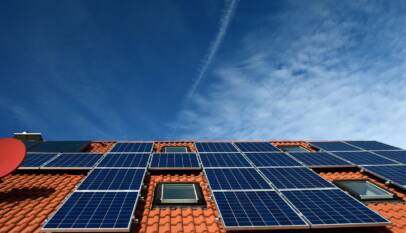
Building integrated photovoltaics (BIPV) combine solar energy technology directly into a building’s structure, replacing traditional materials like roofs, facades, or windows. This integration allows buildings to generate electricity while maintaining their aesthetic and functional roles.
The technology offers a seamless way to incorporate renewable energy without requiring separate solar panel installations. It presents opportunities for architects and engineers to innovate in sustainable design while reducing a building’s carbon footprint.
BIPV systems vary in type and application, making them adaptable to different building designs and climates. Their growing adoption reflects a shift towards more energy-efficient and eco-friendly construction practices.
Overview of Building Integrated Photovoltaics
Building Integrated Photovoltaics (BIPV) combine solar energy generation with building materials. They serve dual purposes: functioning as part of the building envelope and producing electricity. This integration impacts design, materials, and energy efficiency.
What Are Building Integrated Photovoltaics?
BIPV refers to photovoltaic materials that are incorporated directly into building components such as roofs, facades, windows, and skylights. Unlike traditional solar panels mounted on racks, BIPV replaces conventional materials, serving as structural or aesthetic elements.
They convert sunlight into electricity while providing weather protection and thermal insulation. BIPV systems can be custom-designed to fit architectural requirements, maintaining building aesthetics. These systems help reduce energy costs by generating onsite power and can contribute to certifications like LEED.
Types of BIPV Systems
Common BIPV types include:
- Roof-integrated modules: Solar shingles or tiles replacing standard roofing materials.
- Façade systems: Photovoltaic glass panels or curtain walls integrated into external walls.
- Window-integrated systems: Semi-transparent solar cells embedded in glass for daylight and power.
- Canopies and shading devices: Solar panels that provide shade and generate electricity simultaneously.
Each type varies in efficiency, cost, and installation complexity. Selection depends on the building’s design, orientation, and energy needs. Some systems offer flexibility for curved surfaces or different architectural styles.
How BIPV Differs from Traditional PV
Unlike traditional PV panels, BIPV is part of the building’s structure, eliminating the need for separate mounting frames. This reduces material use and installation time.
Traditional PV panels are usually added after construction, whereas BIPV is incorporated during design or renovation. BIPV provides multifunctionality, serving as building components while generating power. This integration can also improve building aesthetics by blending solar technology seamlessly.
Energy production per area may be lower for BIPV due to design constraints, but overall building energy efficiency improves because of integrated insulation, reduced heat gain, or shading functions.
Design and Implementation of BIPV
The design and implementation of building integrated photovoltaics involve careful consideration of how solar modules fit within building structures. It requires selecting appropriate architectural styles, precise installation techniques, evaluating energy performance, and complying with legal standards.
Architectural Integration Approaches
BIPV systems can be incorporated into various building components, including facades, roofs, and windows. The choice depends on aesthetics, structural capability, and energy goals. For example, semi-transparent modules are ideal for skylights and curtain walls, allowing natural light while generating electricity.
Flat roofs often use thin-film PV materials to maintain low profiles. Facades may integrate rigid, framed modules within cladding systems. Designers must balance sunlight exposure with the building’s orientation and shading to optimize energy output.
Material compatibility and weather resistance are crucial. Modules should match or complement existing materials in color and texture to prevent visual discord. Modular design also facilitates easier replacement and maintenance over time.
Installation Methods
BIPV installation demands precision and coordination with building engineering. Modules can be mounted as part of the building envelope or retrofit onto existing surfaces. Integrating PV during construction reduces latency and structural modifications.
Common mounting techniques include direct adhesion to structural substrates, mechanical fastening with brackets, or embedding within glazing units. Electrical connections require weatherproof junction boxes and conduit integration.
Proper sealing prevents water infiltration and ensures airtightness. Installers must verify load-bearing capacity, especially on roofs, to support additional weight. Coordination with electrical contractors ensures compliance with wiring and safety codes.
Schedule alignment between construction phases minimizes delays. Prefabrication of PV elements off-site can streamline installation and reduce labor costs.
Performance and Efficiency Factors
BIPV performance hinges on solar irradiance, module efficiency, and system design. Orientation and tilt angle directly affect energy capture, with south-facing placements preferred in the northern hemisphere.
Thermal management is significant since solar modules lose efficiency in high temperatures. Using ventilated mounting systems or selecting materials with good heat dissipation improves output. Shading from nearby buildings or trees reduces daily yield and must be analyzed early.
Electrical design influences efficiency; proper inverter selection and system monitoring assist in maximizing energy harvest. Dust accumulation and dirt also degrade performance, requiring routine cleaning protocols.
Software tools like PVsyst model performance under site-specific conditions, supporting better system design decisions.
Regulations and Standards for BIPV
BIPV must comply with building codes, electrical standards, and fire safety regulations. Relevant standards include IEEE 1547 for grid interconnection and IEC 61730 for module safety.
Local zoning laws may restrict the aesthetic appearance or installation locations. Permits often require energy production estimates and structural engineering reports.
Fire safety standards, such as UL 790, test module resistance to flame and impact. Compliance ensures occupant safety and reduces insurance liabilities.
Documentation of compliance and quality assurance is necessary for obtaining government incentives and subsidies. Adhering to international standards simplifies cross-border project development.
Kongo Tech Leading Innovation in African Technology Solutions
Kongo Tech specializes in developing innovative digital solutions tailored to African mark…





